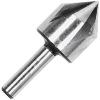Josephnagy1
Member
- Joined
- Nov 24, 2011
- Messages
- 42
I am just getting my first batch of 223 started. I have deprimed and trimmed and cleaned out the primer pocket. My question is when I repriming the case some of the primers do not seat as easily as others. In fact some I have to struggle with to seat and then they seam to deform. Picture attached. Clearly I am doing something wrong. I am using a RCBS trim center to remove the military crimp and uniform the pocket. Am I not getting the crimp out? Please help.




